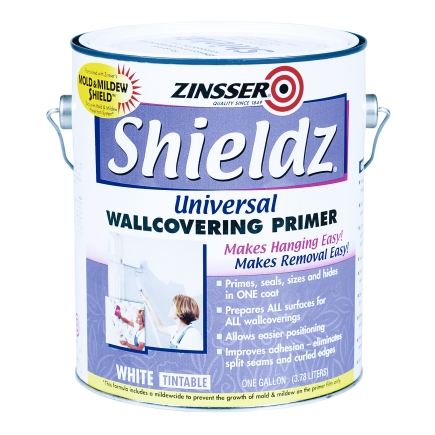Do You Need To Prime Walls Before Wallpapering?

With any home improvement project, doing the job right is a job well done. Although it may take longer than you intend due to unexpected, but inevitable snags along the way, following the proper steps in completing the job produces beautiful work you can be proud of. This is no more relevant than in the case of wallpapering.
Although throwing the paper up right away may be tempting, it may not end up giving you the long lasting results and quality you would expect. Whether hanging wallpaper yourself or relying on a professional, every step should be followed to ensure your paper is properly installed. One of the most important of these steps is priming.
By priming your walls with either an acrylic, alkyd, or PVA primer, depending on the surface type, will ensure your wallpaper adheres properly to the surface without damaging the wall.
Protecting The Wall
Primer creates a barrier between the wall and the paper so that the adhesive doesn’t overly bond with the wall material. An example of this is wallpapering directly onto unprimed drywall. The gypsum material in the drywall overly bonds with the adhesive in the wallpaper, which makes wallpaper incredibly difficult to remove without damaging the wall.
Blocking Color
Priming also blocks color from showing through the new wallpaper. This is especially true if you’re hanging wallpaper on brightly colored walls. The last thing you’d want is to hang your beautiful new wallpaper, only to notice that bright green hue from the previous homeowner’s wall color is showing right through.
The Issue Of Latex
You may be inclined towards putting up wallpaper directly on latex paint covered walls, especially since the most popular wallpaper primer is latex based anyway. But, there’s a big difference between latex paint and latex based wallpaper primer.
Latex paint is often porous, allowing the wall to breathe. When the wallpaper adhesive comes into contact with latex paint, there is a real chance the integrity of the paint will degrade, becoming soft, mushy, or rubbery. There’s also a chance the adhesive can pass right through the latex paint, damaging the drywall underneath.
How To Prime Your Walls
The very first thing you’ll need to do before applying primer is ensuring the wall is as smooth as it can be. This means removing any nails or other protrusions, and filling uneven spots, cracks, and holes with putty. Then sand your repairs down so that it’s even with the rest of the wall.
The next step to take before applying primer is giving your walls a good wash. This is simply achieved with a good multi-purpose cleaner, a bucket of warm water, and a sponge. Once the wall has been washed and has dried completely, you can apply your primer.
If you have questions about which primer to use after reading the installation instructions that came with the paper, contact your wallpaper consultant. Although acrylic based primer is used often, there may be some specific surfaces that are best suited for alkyd or PVA primers.
- November - 2025
- September - 2023
- November - 2022
- November - 2021
- June - 2021
- March - 2021
- February - 2021
- January - 2021
- November - 2020
- October - 2020
- June - 2020
- May - 2020
- October - 2019
- June - 2019
-
May - 2019
- What Is The Best Wallpaper Paste?
- Can You Paint Over Wallpaper?
- Is It Hard To Remove Wallpaper?
- Wallpaper vs. Paint: Which Is Better?
- What Is Vinyl Wallpaper?
- Does Wallpaper Have Asbestos?
- Is Wallpaper Waterproof?
- Can Wallpaper Be Hung Over Plywood?
- Which Wallpaper Is Best For The Living Room?
- What Is The Most Durable Wallpaper?
- What is Removable Wallpaper?
- How Do You Order Wallpaper?
- Does Home Depot Carry Wallpaper?
- December - 2018
- October - 2018
- July - 2018
-
June - 2018
- Wallpaper Ideas
- Commercial Wallpaper Installation Costs
- How Long Will Wallpaper Last?
- What Is Peelable Wallpaper?
- How Expensive Is Wallpaper?
- What Is Half Drop Wallpaper?
- Can You Wallpaper Over Textured Walls?
- Wallpaper Designs
- What Is The Average Cost of Wallpaper?
- Is It Cheaper To Paint Or Wallpaper A Room?
- Do You Need To Prime Walls Before Wallpapering?
- Is Wallpaper Removable?
- How Much Does It Cost To Install Wallpaper?
- How Do You Prepare A Wall For Wallpaper?
- What Are The Different Types Of Wallpaper?
- Can I Do Wallpaper In A Bathroom?
- September - 2017
- August - 2017
- June - 2017
- April - 2017
- March - 2017
- December - 2016
-
November - 2016
- Why You Need to Pay Attention to Wallpaper Repeat
- Difference Between Pre-pasted and Non-prepasted Wallpaper
- Wallpaper Dye Lots, Runs, and Batches? Why Do they Matter?
- How To Shop For Wallpaper?
- Wallpaper Recommendations for Large, Uneven Areas – Hallways, Foyers, and Stairs
- When Wallpaper Shrinks and How to Minimize the Problem
- Recommendations for Wallpaper in the Bathroom
- The Purpose of Wallpaper Primer
- Can I Cover Brick and Stone with Wallpaper?
- Which Wallpaper to Use – Paper, Vinyl Coated, Coated Fabric, Solid Vinyl
- Stores That Carry Wallpaper In Stock
- Can I Hang Wallpaper over Wood Panels?
- October - 2016
- September - 2016
- August - 2016
- July - 2016
- June - 2016






